air condition ASTON MARTIN V8 VANTAGE 2010 Repair Manual
[x] Cancel search | Manufacturer: ASTON MARTIN, Model Year: 2010, Model line: V8 VANTAGE, Model: ASTON MARTIN V8 VANTAGE 2010Pages: 947, PDF Size: 43.21 MB
Page 855 of 947
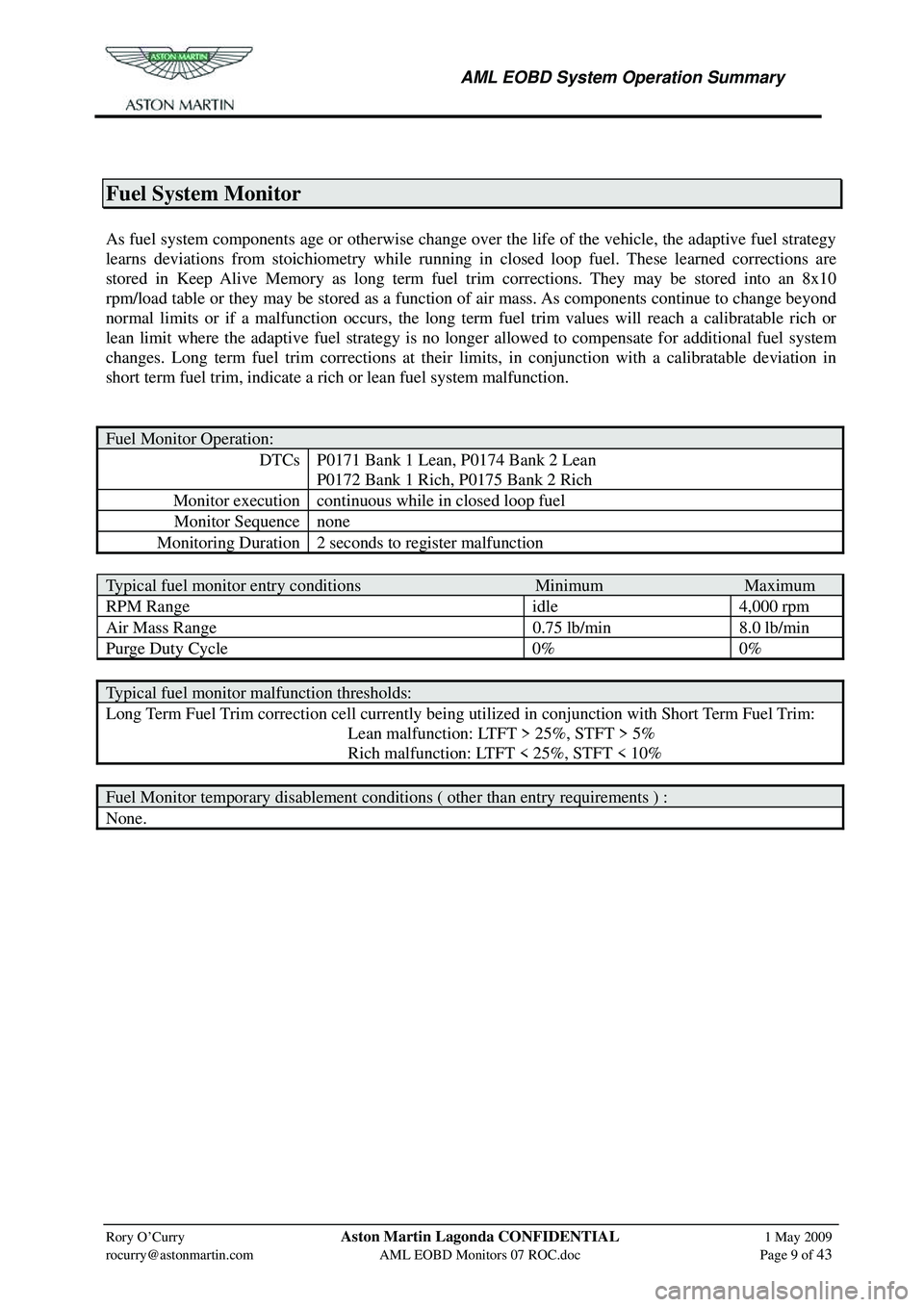
AML EOBD System Operation Summary
Rory O’Curry Aston Martin Lagonda CONFIDENTIAL 1 May 2009
[email protected] AML EOBD Monitors 07 ROC.doc Page 9 of 43
Fuel System Monitor
As fuel system components age or otherwise change over the life of the vehicle, the adaptive fuel strategy
learns deviations from stoichiometry while running in closed loop fuel. These learned corrections are
stored in Keep Alive Memory as long term fuel tr im corrections. They may be stored into an 8x10
rpm/load table or they may be stored as a function of air mass. As components continue to change beyond
normal limits or if a malfunction occurs, the long term fuel trim values will reach a calibratable rich or
lean limit where the adaptive fuel strategy is no longe r allowed to compensate for additional fuel system
changes. Long term fuel trim corrections at their limits, in conjunction with a calibratable deviation in
short term fuel trim, indicate a rich or lean fuel system malfunction.
Fuel Monitor Operation:
DTCs P0171 Bank 1 Lean, P0174 Bank 2 Lean
P0172 Bank 1 Rich, P0175 Bank 2 Rich
Monitor execution continuous while in closed loop fuel
Monitor Sequence none
Monitoring Duration 2 seconds to register malfunction
Typical fuel monitor entry conditions Minimum Maximum
RPM Range idle 4,000 rpm
Air Mass Range 0.75 lb/min 8.0 lb/min
Purge Duty Cycle 0% 0%
Typical fuel monitor malfunction thresholds:
Long Term Fuel Trim correction cell currently being utilized in conjunction with Short Term Fuel Trim:
Lean malfunction: LTFT > 25%, STFT > 5%
Rich malfunction: LTFT < 25%, STFT < 10%
Fuel Monitor temporary disablement conditions ( other than entry requirements ) :
None.
Page 856 of 947
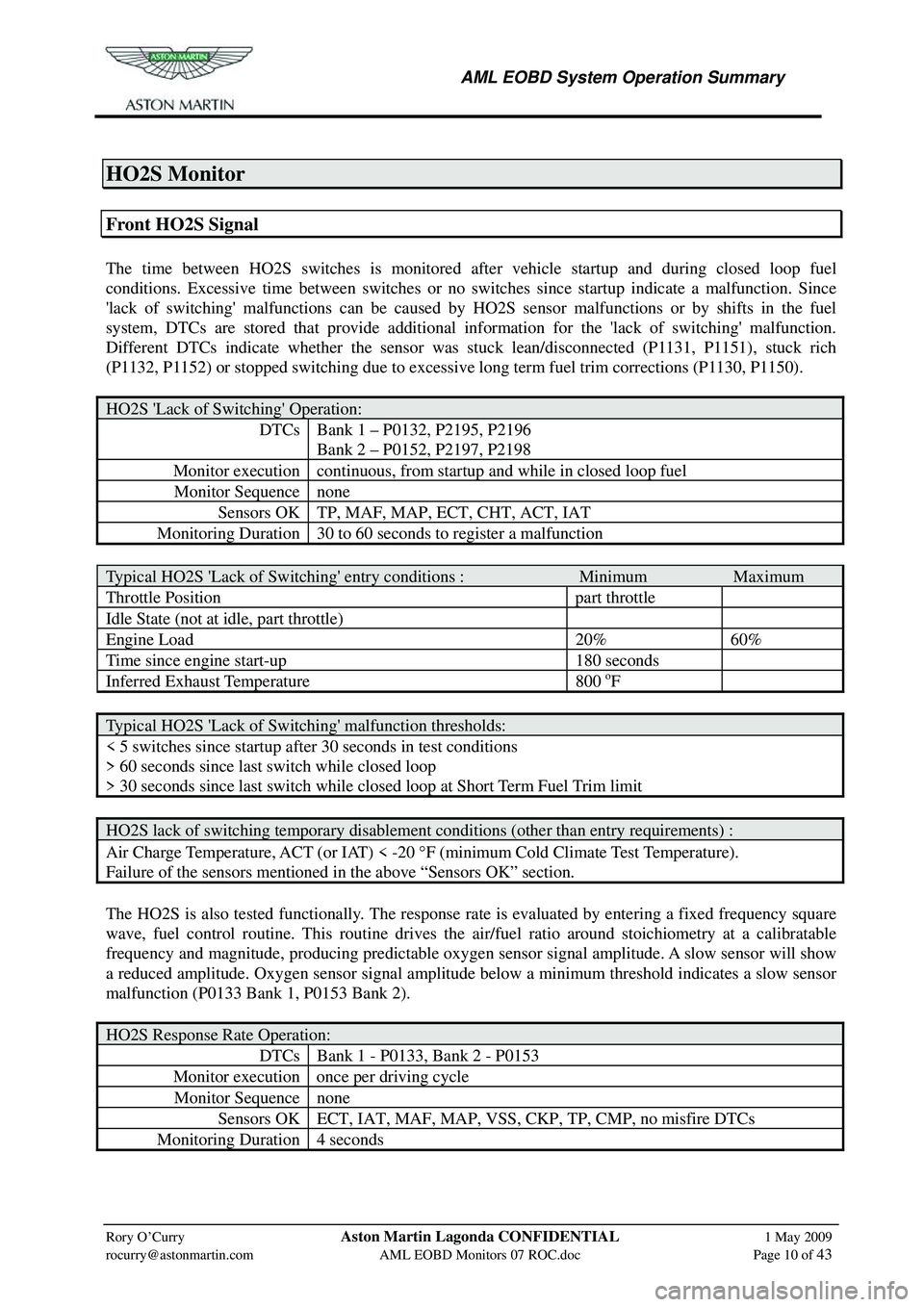
AML EOBD System Operation Summary
Rory O’Curry Aston Martin Lagonda CONFIDENTIAL 1 May 2009
[email protected] AML EOBD Monitors 07 ROC.doc Page 10 of 43
HO2S Monitor
Front HO2S Signal
The time between HO2S switches is monitored after vehicle startup and during closed loop fuel
conditions. Excessive time between switches or no switc hes since startup indicate a malfunction. Since
'lack of switching' malfunctions can be caused by HO2S sensor malfunctions or by shifts in the fuel
system, DTCs are stored that provide additional information for the 'lack of switching' malfunction.
Different DTCs indicate whether the sensor was st uck lean/disconnected (P1131, P1151), stuck rich
(P1132, P1152) or stopped switching due to excessive long term fuel trim corrections (P1130, P1150).
HO2S 'Lack of Switching' Operation:
DTCs Bank 1 – P0132, P2195, P2196
Bank 2 – P0152, P2197, P2198
Monitor execution continuous, from startup and while in closed loop fuel
Monitor Sequence none
Sensors OK TP, MAF, MAP, ECT, CHT, ACT, IAT
Monitoring Duration 30 to 60 seconds to register a malfunction
Typical HO2S 'Lack of Switching' entry conditions : Minimum Maximum
Throttle Position part throttle
Idle State (not at idle, part throttle)
Engine Load 20% 60%
Time since engine start-up 180 seconds
Inferred Exhaust Temperature 800 oF
Typical HO2S 'Lack of Switching' malfunction thresholds:
< 5 switches since startup after 30 seconds in test conditions
> 60 seconds since last switch while closed loop
> 30 seconds since last switch while closed loop at Short Term Fuel Trim limit
HO2S lack of switching temporary disablement conditions (other than entry requirements) :
Air Charge Temperature, ACT (or IAT) < -20 °F (minimum Cold Climate Test Temperature).
Failure of the sensors mentioned in the above “Sensors OK” section.
The HO2S is also tested functionally. The response rate is evaluated by enteri ng a fixed frequency square
wave, fuel control routine. This routine drives the air/fuel ratio around stoichiometry at a calibratable
frequency and magnitude, producing pr edictable oxygen sensor signal amplitude. A slow sensor will show
a reduced amplitude. Oxygen sensor signal amplitude below a minimum threshold indicates a slow sensor
malfunction (P0133 Bank 1, P0153 Bank 2).
HO2S Response Rate Operation:
DTCs Bank 1 - P0133, Bank 2 - P0153
Monitor execution once per driving cycle
Monitor Sequence none
Sensors OK ECT, IAT, MAF, MAP, VSS, CKP, TP, CMP, no misfire DTCs
Monitoring Duration 4 seconds
Page 857 of 947
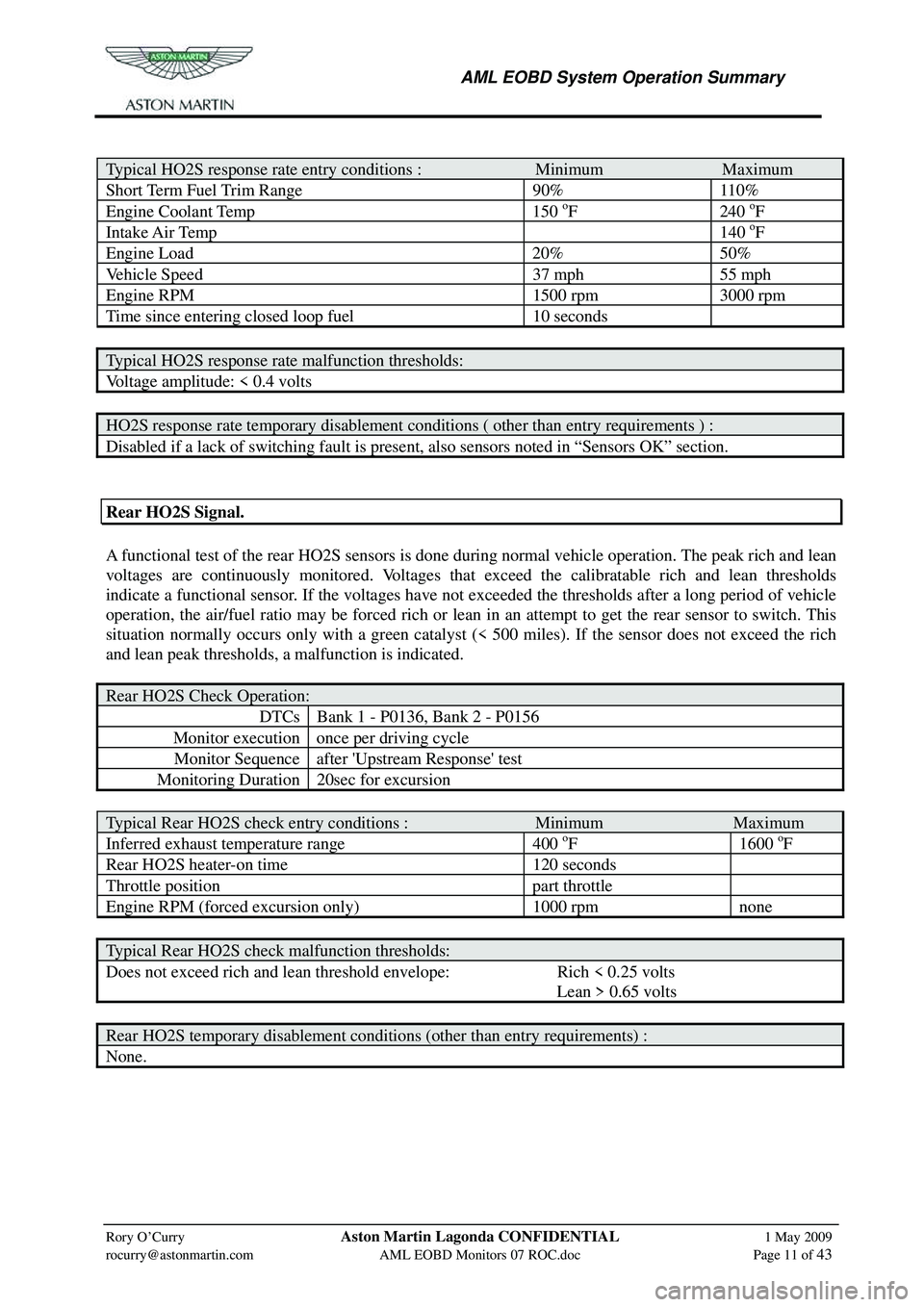
AML EOBD System Operation Summary
Rory O’Curry Aston Martin Lagonda CONFIDENTIAL 1 May 2009
[email protected] AML EOBD Monitors 07 ROC.doc Page 11 of 43
Typical HO2S response rate entry conditions : Minimum Maximum
Short Term Fuel Trim Range 90% 110%
Engine Coolant Temp 150 oF 240 oF
Intake Air Temp 140 oF
Engine Load 20% 50%
Vehicle Speed 37 mph 55 mph
Engine RPM 1500 rpm 3000 rpm
Time since entering closed loop fuel 10 seconds
Typical HO2S response rate malfunction thresholds:
Voltage amplitude: < 0.4 volts
HO2S response rate temporary disablement conditions ( other than entry requirements ) :
Disabled if a lack of switching fault is present, also sensors noted in “Sensors OK” section.
Rear HO2S Signal.
A functional test of the rear HO2S sensors is done dur ing normal vehicle operation. The peak rich and lean
voltages are continuously monitored. Voltages that exceed the calibratable rich and lean thresholds
indicate a functional sensor. If the voltages have not ex ceeded the thresholds after a long period of vehicle
operation, the air/fuel ratio may be forced rich or lean in an attempt to get the rear sensor to switch. This
situation normally occurs only with a green catalyst (< 500 miles). If the sensor does not exceed the rich
and lean peak thresholds, a malfunction is indicated.
Rear HO2S Check Operation:
DTCs Bank 1 - P0136, Bank 2 - P0156
Monitor execution once per driving cycle
Monitor Sequence after 'Upstream Response' test
Monitoring Duration 20sec for excursion
Typical Rear HO2S check entry conditions : Minimum Maximum
Inferred exhaust temperature range 400 oF 1600 oF
Rear HO2S heater-on time 120 seconds
Throttle position part throttle
Engine RPM (forced excursion only) 1000 rpm none
Typical Rear HO2S check malfunction thresholds:
Does not exceed rich and lean threshold envelope: Rich < 0.25 volts
Lean > 0.65 volts
Rear HO2S temporary disablement conditions (other than entry requirements) :
None.
Page 860 of 947
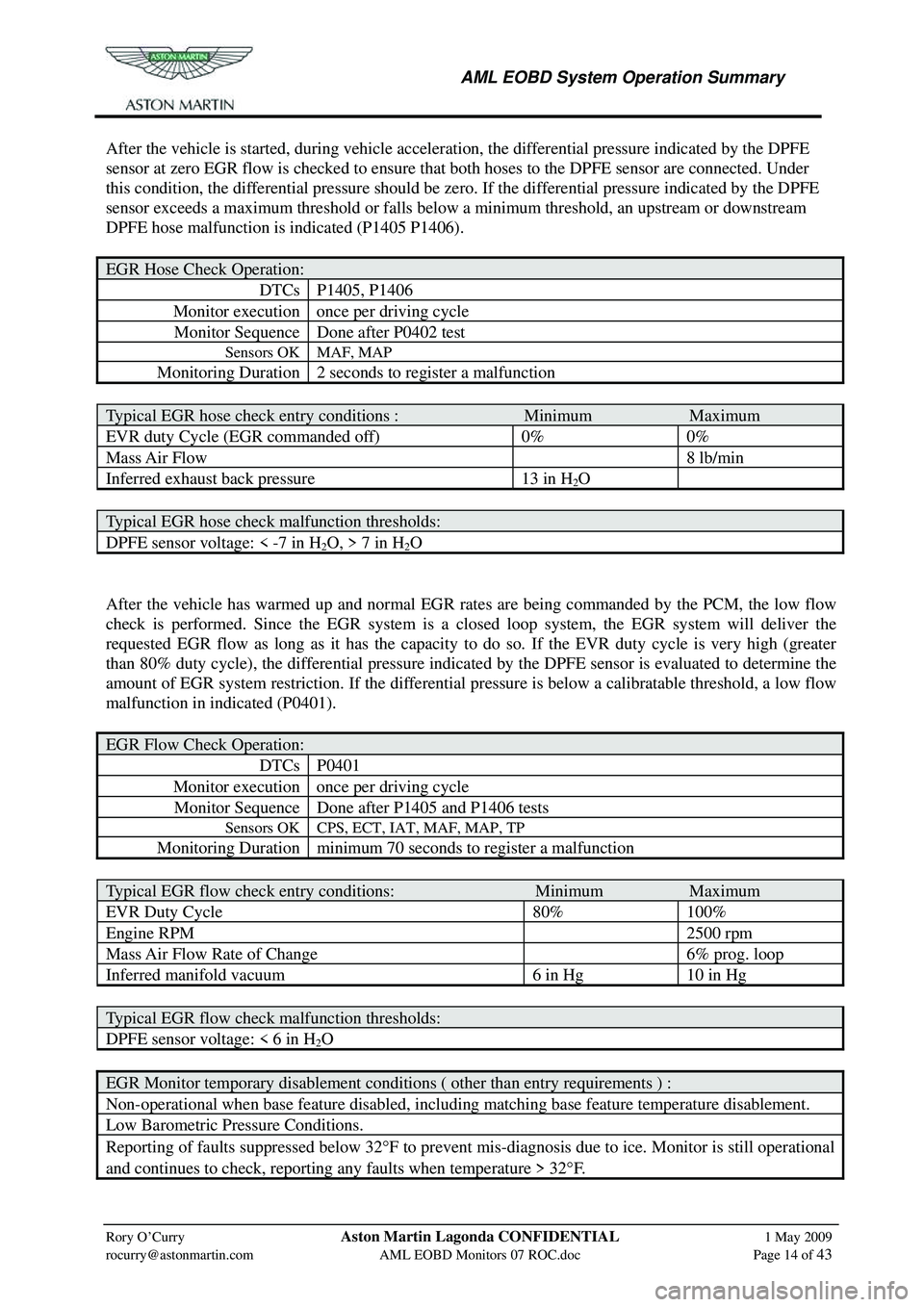
AML EOBD System Operation Summary
Rory O’Curry Aston Martin Lagonda CONFIDENTIAL 1 May 2009
[email protected] AML EOBD Monitors 07 ROC.doc Page 14 of 43
After the vehicle is started, during vehicle acceleration, the differential pressure indicated by the DPFE
sensor at zero EGR flow is checked to ensure that both hoses to the DPFE sensor are connected. Under
this condition, the differential pressure should be zer o. If the differential pressure indicated by the DPFE
sensor exceeds a maximum threshold or falls below a minimum threshold, an upstream or downstream
DPFE hose malfunction is indicated (P1405 P1406).
EGR Hose Check Operation:
DTCs P1405, P1406
Monitor execution once per driving cycle
Monitor Sequence Done after P0402 test
Sensors OK MAF, MAP
Monitoring Duration 2 seconds to register a malfunction
Typical EGR hose check entry conditions : Minimum Maximum
EVR duty Cycle (EGR commanded off) 0% 0%
Mass Air Flow 8 lb/min
Inferred exhaust back pressure 13 in H2O
Typical EGR hose check malfunction thresholds:
DPFE sensor voltage: < -7 in H2O, > 7 in H2O
After the vehicle has warmed up and normal EGR rates are being commanded by the PCM, the low flow
check is performed. Since the EGR system is a closed loop system, the EGR system will deliver the
requested EGR flow as long as it has the capacity to do so. If the EVR duty cycle is very high (greater
than 80% duty cycle), the differential pressure indicated by the DPFE sensor is evaluated to determine the
amount of EGR system restriction. If the differential pr essure is below a calibratable threshold, a low flow
malfunction in indicated (P0401).
EGR Flow Check Operation:
DTCs P0401
Monitor execution once per driving cycle
Monitor Sequence Done after P1405 and P1406 tests
Sensors OK CPS, ECT, IAT, MAF, MAP, TP
Monitoring Duration minimum 70 seconds to register a malfunction
Typical EGR flow check entry conditions: Minimum Maximum
EVR Duty Cycle 80% 100%
Engine RPM 2500 rpm
Mass Air Flow Rate of Change 6% prog. loop
Inferred manifold vacuum 6 in Hg 10 in Hg
Typical EGR flow check malfunction thresholds:
DPFE sensor voltage: < 6 in H2O
EGR Monitor temporary disablement conditions ( other than entry requirements ) :
Non-operational when base feature disabled, including matching base feature temperature disablement.
Low Barometric Pressure Conditions.
Reporting of faults suppressed below 32° F to prevent mis-diagnosis due to ice. Monitor is still operational
and continues to check, reporting any faults when temperature > 32 °F.
Page 864 of 947

AML EOBD System Operation Summary
Rory O’Curry Aston Martin Lagonda CONFIDENTIAL 1 May 2009
Dual MAF Diagnostic
Dual MAF Hardware
The V8 uses a common dirty air pick-up, which feeds twin air filters and MAF meters before recombining the two air streams in a junction prior to the throttle.
[email protected] AML EOBD Monitors 07 ROC.doc Page 18 of 43
FilterFilter
Filter Filter
Filter Filter
Filter Filter
MAF
meters
Normal Operation Side Wind or Partial
Blockage Backflow
Total Blockage
MAF meters receive an
equal share of the airflow. One MAF meter receives
an airflow greater than the total engine consumption. One MAF meter
receives airflow equal to the total airflow.
MAF meters receive
unequal airflows. This is due to severe side
wind. Fault judgement is
de
pendant on severity.
This can either be due
to a side wind or a partial blockage. One MAF meter will
measure zero airflow and this needs to be
determined to prevent false circuit faults.
Low engine airflow
conditions are
particularly susceptible to side wind. Fault judgement is
dependant on severity.
Fault judgement is
dependant on severity.
Page 866 of 947

AML EOBD System Operation Summary
Rory O’Curry Aston Martin Lagonda CONFIDENTIAL 1 May 2009
Fault Matrix
ConditionMAF 1 + MAF 2 = EST
MAF 1 = ½ EST
MAF 2 = ½ EST
MAF 1 < MAF 2
MAF 1 low voltage
MAF 2 low voltage
MAF 1 high voltage
MAF 2 high voltage
MAF 1 > EST
MAF 2 > EST
MAF 1 = MAF 2Air Charge P-codes
Normal operating. YY--------f(maf_raw)
None
MAF 1 partly blocked. N-N----f(maf_raw)
P010F, P0100
MAF 1 fully blocked @ low load.
Y-N---- f(maf_raw)
P010F, P0100
MAF 2 partly blocked. -N-N- - -f(maf_raw)
P010F, P010A
MAF 2 fully blocked @ low load. -Y-N---f(maf_raw)
P010F, P010
AMAF 1 shorted to ground.
-Y-N----f(maf_raw)
P0102
MAF 1 shorted to high. -N-Y----f(maf_raw)
P0103
MAF 1 failed in range. -N-N----f(maf_raw)
P0101
MAF 2 shorted to ground. --Y-N---f(maf_raw)
P010C
MAF 2 shorted high. --N-Y---f(maf_raw)
P010D
MAF 2 failed in range. --N-N---f(maf_raw)
P010B
Estimated value wrong. --
Yf(maf_raw)None
MAF 1 and MAF 2 failed in range. --Nf(fmem)
P0101, P010B
Backflow via MAF 1. -
Y-f(fmem)
P0104
MAF 1 short to ground MAF 2 failed in rng. -N-f(fmem)
P0102, P010B
MAF 1 shorted high, MAF 2 failed in rng. -NN
YN---f(fmem)
P0103, P010B
Backflow via MAF 2.Y-- f(fmem)
P010E
MAF 1 failed in rng, MAF2 short to ground. N- -f(fmem)
P0101, P010C
MAF 1 failed in rng, MAF 2 shorted high. NNN
Y---f(fmem)
P0101, P010D
MAF 1 & MAF 2 shorted to ground. -YYNN---f(fmem)
P0102, P010C
MAF 1 & MAF 2 shorted high. -NNYY---f(fmem)
P0103, P010D
Severe backflow via MAF 2.Y-- f(fmem)
P010E
MAF 2 fully blocked @ high load N- -f(fmem)
P010F, P010B
Severe backflow via MAF 1. -
Y-f(fmem)
P0104
MAF 1 fully blocked @ high load. -N-f(fmem)
P010F, P0101
YNNY N
N
NN - NNNN
-
-NYY N
-NYNN
-YNN
Y
N
NY
Y
NN
YN
[email protected] AML EOBD Monitors 07 ROC.doc Page 20 of 43
Page 867 of 947

AML EOBD System Operation Summary
Rory O’Curry Aston Martin Lagonda CONFIDENTIAL 1 May 2009
[email protected] AML EOBD Monitors 07 ROC.doc Page 21 of 43
Dual MAF Diagnostic Operation:
DTCs P0100 – Mass Air Flow A Circuit
P0101 – Mass Air Flow A Circuit Range/Performance
P0102 – Mass Air Flow A Circuit Low Input
P0103 – Mass Air Flow A Circuit High Input
P0104 – Mass Air Flow A Circuit Intermittent/Erratic
P010A – Mass Air Flow B Circuit
P010B – Mass Air Flow B Circuit Range/Performance
P010C – Mass Air Flow B Circuit Low Input
P010D – Mass Air Flow B Circuit High Input
P010E – Mass Air Flow B Circuit Intermittent/Erratic
P010F – Mass Air Flow Sensors A/B Correlation
Monitor execution Continuous (exceptions below)
Monitor Sequence Continuous (exceptions below)
Sensors/Components OK No Throttle Position Failure
No Vehicle Speed Failure
Monitoring Duration Continuous (exceptions below)
Global Entry Conditions
Entry condition Minimum Maximum
Battery Voltage 11 volts 18 volt
Global Abort Conditions
SAIR monitor running
Abort Conditions for P0100,P0101,P010A,P010B,P010F
Throttle position < 3 degrees & Vehicle Speed > 15mph
Page 869 of 947
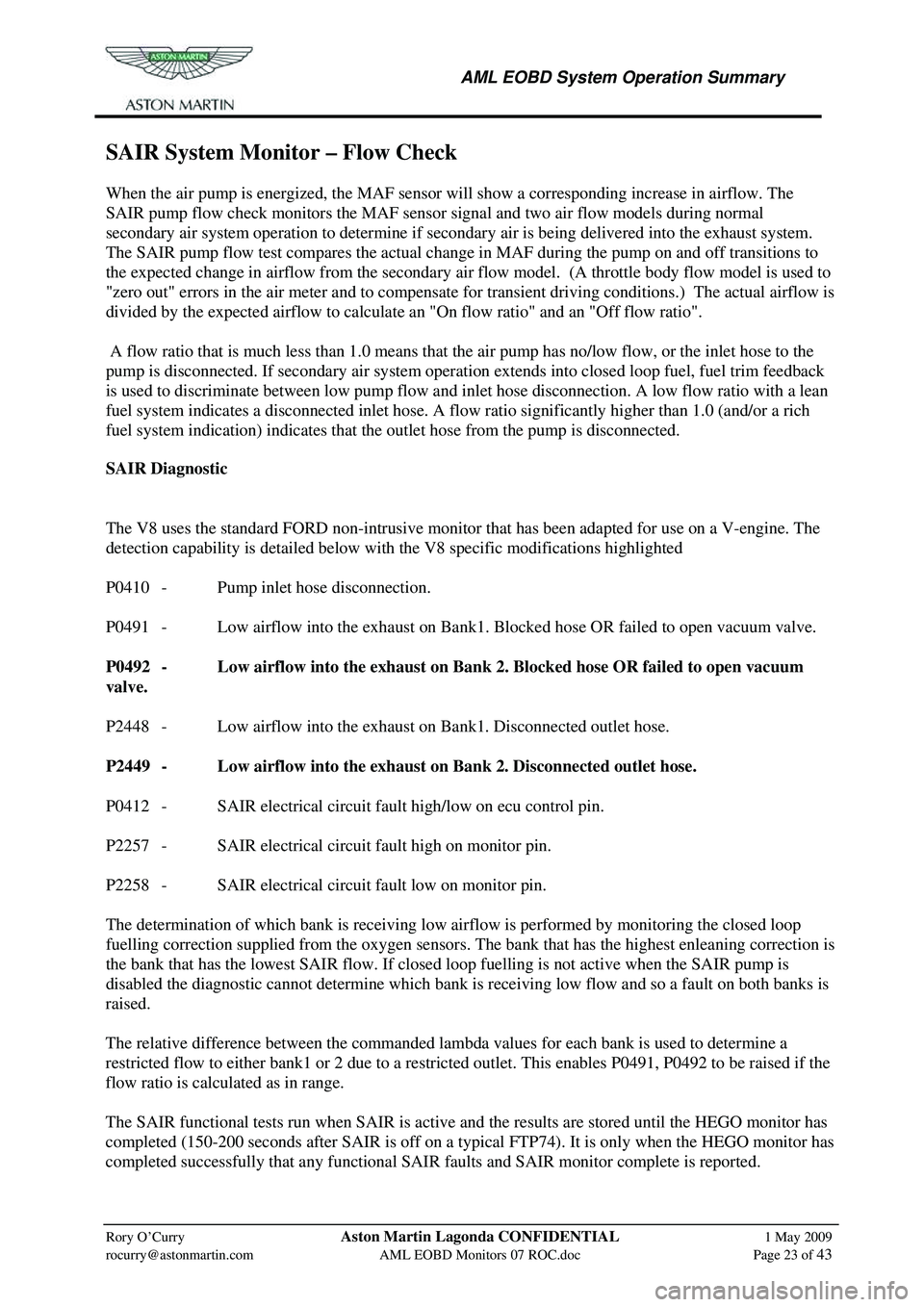
AML EOBD System Operation Summary
Rory O’Curry Aston Martin Lagonda CONFIDENTIAL 1 May 2009
[email protected] AML EOBD Monitors 07 ROC.doc Page 23 of 43
SAIR System Monitor – Flow Check
When the air pump is energized, the MAF sensor will show a corresponding increase in airflow. The
SAIR pump flow check monitors the MAF sensor signal and two air flow models during normal
secondary air system operation to determine if secondary air is being delivered into the exhaust system.
The SAIR pump flow test compares the actual change in MAF during the pump on and off transitions to
the expected change in airflow from the secondary air fl ow model. (A throttle body flow model is used to
"zero out" errors in the air meter and to compensate fo r transient driving conditions.) The actual airflow is
divided by the expected airflow to calculate an "On flow ratio" and an "Off flow ratio".
A flow ratio that is much less than 1.0 means that the air pump has no/low flow, or the inlet hose to the
pump is disconnected. If secondary air system operation ex tends into closed loop fuel, fuel trim feedback
is used to discriminate between low pump flow and in let hose disconnection. A low flow ratio with a lean
fuel system indicates a disconnected inlet hose. A flow ratio significantly higher than 1.0 (and/or a rich
fuel system indication) indicates that th e outlet hose from the pump is disconnected.
SAIR Diagnostic
The V8 uses the standard FORD non-intrusive monitor that has been adapted for use on a V-engine. The
detection capability is detailed below with the V8 specific modifications highlighted
P0410 - Pump inlet hose disconnection.
P0491 - Low airflow into the exhaust on Bank1. Blocked hose OR failed to open vacuum valve.
P0492 - Low airflow into the exhaust on Bank 2. Blocked hose OR failed to open vacuum
valve.
P2448 - Low airflow into the exhaust on Bank1. Disconnected outlet hose.
P2449 - Low airflow into the exhaust on Bank 2. Disconnected outlet hose.
P0412 - SAIR electrical circuit fault high/low on ecu control pin.
P2257 - SAIR electrical circuit fault high on monitor pin.
P2258 - SAIR electrical circuit fault low on monitor pin.
The determination of which bank is receiving low ai rflow is performed by monitoring the closed loop
fuelling correction supplied from the oxygen sensors. The bank that has the highest enleaning correction is
the bank that has the lowest SAIR flow. If closed loop fuelling is not active when the SAIR pump is
disabled the diagnostic cannot determ ine which bank is receiving low flow and so a fault on both banks is
raised.
The relative difference between the commanded lambda values for each bank is used to determine a
restricted flow to either bank1 or 2 due to a restricted outlet. This enables P0491, P0492 to be raised if the
flow ratio is calculated as in range.
The SAIR functional tests run when SAIR is active and the results are stored until the HEGO monitor has
completed (150-200 seconds after SAIR is off on a typical FTP74). It is only when the HEGO monitor has
completed successfully that any functional SAIR fa ults and SAIR monitor complete is reported.
Page 870 of 947
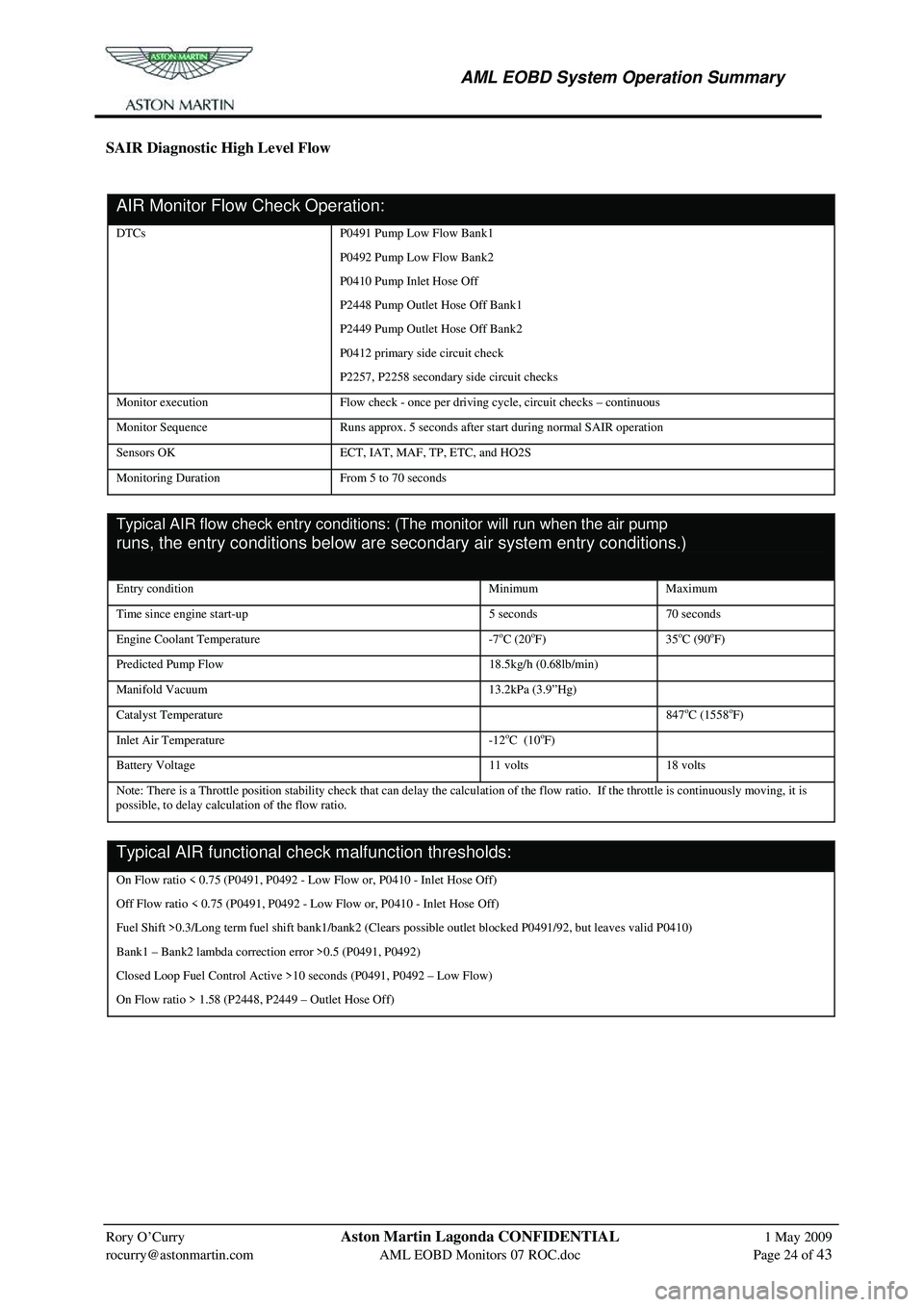
AML EOBD System Operation Summary
Rory O’Curry Aston Martin Lagonda CONFIDENTIAL 1 May 2009
[email protected] AML EOBD Monitors 07 ROC.doc Page 24 of 43
SAIR Diagnostic High Level Flow
AIR Monitor Flow Check Operation: onitor Flow Check Operation:
DTCs P0491 Pump Low Flow Bank1
P0492 Pump Low Flow Bank2
P0410 Pump Inlet Hose Off
P2448 Pump Outlet Hose Off Bank1
P2449 Pump Outlet Hose Off Bank2
P0412 primary side circuit check
P2257, P2258 secondary side circuit checks
Monitor execution Flow check - once per driving cycle, circuit checks – continuous
Monitor Sequence Runs approx. 5 seconds after start during normal SAIR operation
Sensors OK ECT, IAT, MAF, TP, ETC, and HO2S
Monitoring Duration From 5 to 70 seconds
Typical AIR flow check entry conditions: (The monitor will run when the air pump
runs, the entry conditions below are secondary air system entry conditions.) re secondary air
system entry conditions.)
Entry condition Minimum Maximum
Time since engine start-up 5 seconds 70 seconds
Engine Coolant Temperature -7oC (20oF) 35oC (90oF)
Predicted Pump Flow 18.5kg/h (0.68lb/min)
Manifold Vacuum 13.2kPa (3.9”Hg)
Catalyst Temperature 847oC (1558oF)
Inlet Air Temperature -12oC (10oF)
Battery Voltage 11 volts 18 volts
Note: There is a Throttle position stability ch eck that can delay the calculation of the flow ratio. If the throttle is continuously moving, it is
possible, to delay calculation of the flow ratio.
Typical AIR functional check malfunction thresholds:heck malfunction thresholds:
On Flow ratio < 0.75 (P0491, P0492 - Low Flow or, P0410 - Inlet Hose Off)
Off Flow ratio < 0.75 (P0491, P0492 - Lo w Flow or, P0410 - Inlet Hose Off)
Fuel Shift >0.3/Long term fuel shift bank1/bank2 (Clears possible outlet blocked P0491/92, but leaves valid P0410)
Bank1 – Bank2 lambda correcti on error >0.5 (P0491, P0492)
Closed Loop Fuel Control Active >10 seconds (P0491, P0492 – Low Flow)
On Flow ratio > 1.58 (P2448, P2449 – Outlet Hose Off)
Page 873 of 947
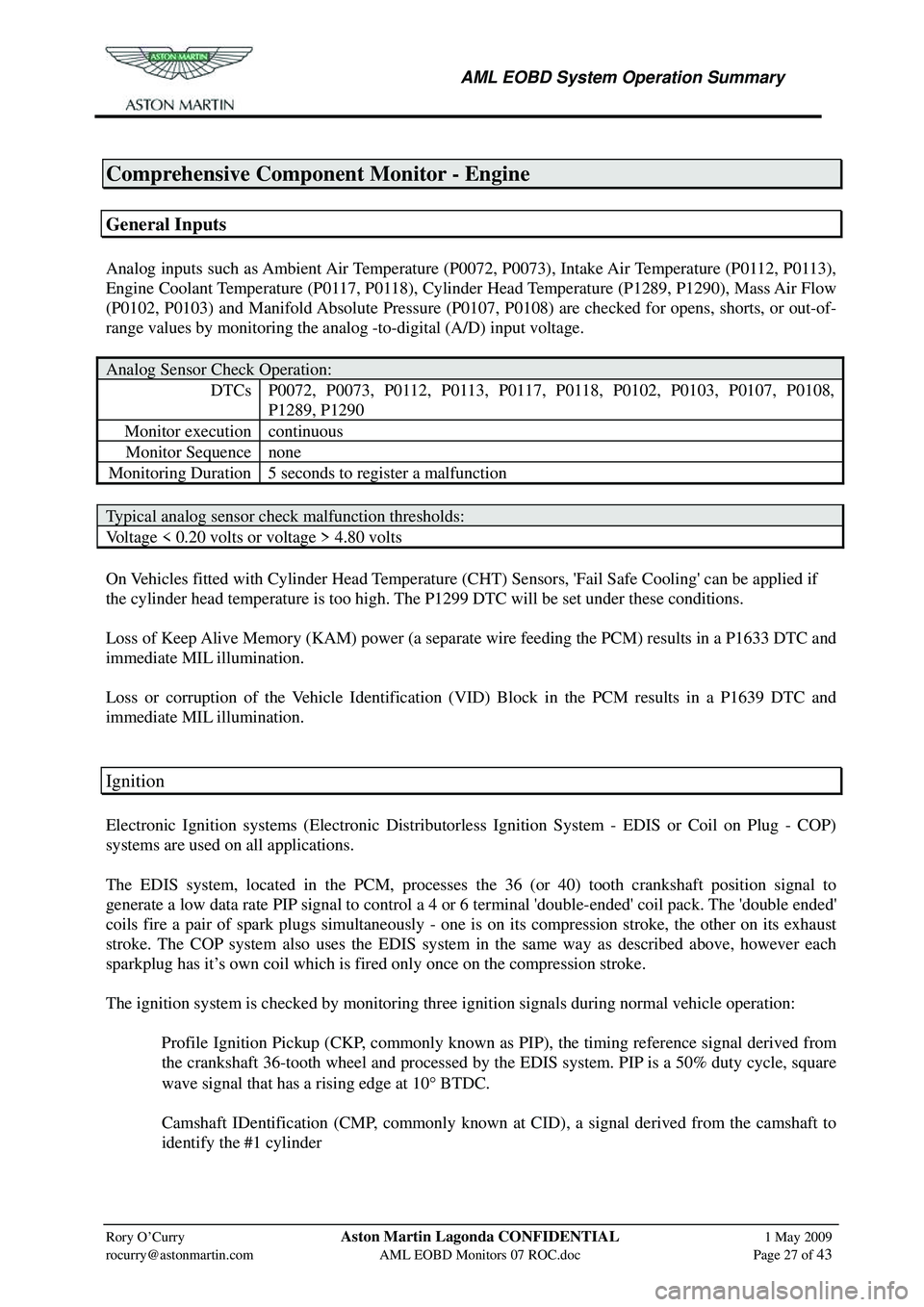
AML EOBD System Operation Summary
Rory O’Curry Aston Martin Lagonda CONFIDENTIAL 1 May 2009
[email protected] AML EOBD Monitors 07 ROC.doc Page 27 of 43
Comprehensive Component Monitor - Engine
General Inputs
Analog inputs such as Ambient Air Temperature (P0072, P0073), Intake Air Temperature (P0112, P0113),
Engine Coolant Temperature (P0117, P0118), Cylinder Head Temperature (P1289, P1290), Mass Air Flow
(P0102, P0103) and Manifold Absolute Pressure (P0107, P0108) are checked for opens, shorts, or out-of-
range values by monitoring the analog -to-digital (A/D) input voltage.
Analog Sensor Check Operation:
DTCs P0072, P0073, P0112, P0113, P0117, P0118, P0102, P0103, P0107, P0108,
P1289, P1290
Monitor execution continuous
Monitor Sequence none
Monitoring Duration 5 seconds to register a malfunction
Typical analog sensor check malfunction thresholds:
Voltage < 0.20 volts or voltage > 4.80 volts
On Vehicles fitted with Cylinder Head Temperature (CHT ) Sensors, 'Fail Safe Cooling' can be applied if
the cylinder head temperature is too high. The P1299 DTC will be set under these conditions.
Loss of Keep Alive Memory (KAM) power (a separate wire feeding the PCM) results in a P1633 DTC and
immediate MIL illumination.
Loss or corruption of the Vehicle Identification (VID) Block in the PCM results in a P1639 DTC and
immediate MIL illumination.
Ignition
Electronic Ignition systems (Electronic Distributorless Ignition System - EDIS or Coil on Plug - COP)
systems are used on all applications.
The EDIS system, located in the PCM, processes the 36 (or 40) tooth crankshaft position signal to
generate a low data rate PIP signal to control a 4 or 6 terminal 'double-ended' coil pack. The 'double ended'
coils fire a pair of spark plugs simultaneously - one is on its compression stroke, the other on its exhaust
stroke. The COP system also uses the EDIS system in the same way as described above, however each
sparkplug has it’s own coil which is fired only once on the compression stroke.
The ignition system is checked by monitoring three ignition signals during normal vehicle operation:
Profile Ignition Pickup (CKP, commonly known as PIP), the timing reference signal derived from the crankshaft 36-tooth wheel and processed by the EDIS system. PIP is a 50% duty cycle, square
wave signal that has a rising edge at 10 ° BTDC.
Camshaft IDentification (CMP, commonly known at CID), a signal derived from the camshaft to identify the #1 cylinder